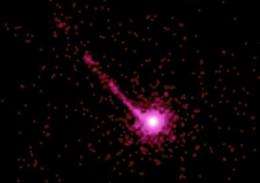Peering into a gateway opened 50 years ago

Saturday marked the 50th anniversary of the discovery of the quasar - an extremely bright object powered by matter falling into a super-massive black hole lying in the heart of a galaxy.
First found in 1963, these strange sources of radio waves initially stumped astronomers: They shone as sharply and intensely as nearby stars, but they appeared to be moving away from Earth far too fast to be in our own Milky Way. Scientists called them quasi-stellar radio sources - or quasars for short.
Eventually, astronomers realized that only a black hole had enough power to produce such bright light from such mind-boggling distances. Compared to faint galaxies, these cosmic beacons offered a tantalizing glimpse into the very early universe - and thus, a window into its evolution.
California Institute of Technology astronomer Maarten Schmidt discovered the first known quasar, 3C273, on March 16, 1963. He spoke with the Los Angeles Times about his groundbreaking discovery.
Question: What was it like to discover such a strange new phenomenon?
Answer: It was really exciting. These quasars - they were so unexpected. It was, I must say, the highlight of my own science in my career.
Q: A "bright spot," you might say.
A: Yup.
Q: How did you come across that first quasar, 3C273?
A: The radio astronomers after World War II were producing catalogs of radio sources that were quite reliable. Usually these radio sources were identified with galaxies. 3C273 was one of the first ones where the identification was not with a galaxy. We believed it originally to be a star.
Q: So you measured the object's redshift, which tells you how much the light from an object is getting stretched out as the object travels away from you. What did this show?
A: Redshifts are just a measure of distance in the universe. High redshifts mean large distances.
If the object were a star, it would have to be in our own galaxy, of course. And the stars in our galaxy have a velocity never larger than 600 kilometers per second - that would be a redshift of 0.2 percent. If a star has a velocity larger than that, it would escape the galaxy. Anything that has a redshift of even 1 percent has to be outside the galaxy.
But when I took a spectrum in 1962 and also in 1963, it turned out that it was redshifted by 16 percent. That corresponds to a velocity off 47,000 kilometers per second.
Q: That's a lot faster.
A: Yes! So it really stood out, and it could not be ignored.
Q: If this strange object was sitting billions of light-years away, how could you see it?
A: It was 40 times more luminous than an entire galaxy of 100 billion stars. It was an exceptional object.
Q: Did you realize it was in the center of another galaxy?
A: No. These quasars occur in the center of galaxies, but are so incredibly bright that they masked the whole galaxy. That took a long time to establish.
Q: Were you surprised by your own conclusions?
A: Absolutely. My wife still tells me I was pacing the floor in the evening and couldn't stop.
At times we thought we were just barking up the wrong tree, but you look at the observations again, and what other explanation could we give?
Q: How did the discovery of quasars change the way we viewed the universe?
A: It allowed us to go back easily in time. For instance, after a number of years I concluded that the number of quasars in the universe had been much larger in the past than it is now, by a factor of 100. And it was the first case where we saw the universe was changing.
This is the evolution of the universe, as it were.
Q: Fifty years later, do we see the universe differently because of quasars?
A: The universe before quasars used to be a rather quiet place - at least, that's what the astronomers thought. And it turned out that all sorts of things are happening.
As some people later on said, it's a violent universe.
More information: This interview has been edited for clarity.
(c)2013 Los Angeles Times
Distributed by MCT Information Services





















